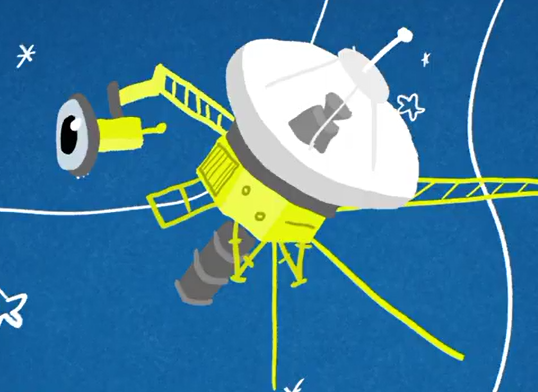Wouldn't it be super cool if we could go visit other planets?
如果我们能去参观其他星球,是不是很酷?
Astronauts have visited the moon before,
宇航员曾到过月球,
but so far no people have ever been to another planet.
但目前还没有人去过其他行星。
Nope, no rats have ever visited another planet, either, Squeaks!
不,吱吱,也没有老鼠去过另一颗行星!
But even though we haven't sent people very far out into space,
即使我们没有把人送到那么远的太空,
we have sent special kinds of spaceships very far away.
但仍发射了几种特殊的宇宙飞船到那里。
The farthest one is called Voyager 1,
发射得最远的叫做“旅行者”1号,
and it's all the way outside of the solar system, in the space between the stars!
它一直在太阳系外、在恒星之间的空间里!
We haven't sent people to visit other planets yet because most of them are really far away,
我们还没送人到其他行星是因为它们中的大多数都太远了,
and they don't have air we can breathe or soil where we can grow food like on Earth.
没有我们可以呼吸的空气或类似地球上能够生长食物的土壤。
So before we send people to other planets,
因此,在我们送人到其他行星之前,
scientists have to figure out how to avoid all the things that might be dangerous about the trip.
科学家们想要确定如何避免旅行中的所有可能危险。
But in the meantime, astronomers, the scientists who study space,
但与此同时,研究太空的天文学家们
have other ways to learn about it, with telescopes, for example.
有其他办法了解它,比如用望远镜。
And if astronomers want to learn even more than they can with a telescope,
如果天文学家想要了解比望远镜看到得还要多的东西,
they might send something called a probe into space.
可能会发射探测器到太空。
A space probe is a kind of spaceship that doesn't have people on it.
太空探测器是一种不载人的宇宙飞船。
It goes out into space and uses its computers, cameras, and other kinds of equipment
它进入太空,利用电脑、照相机和其他设备
to learn about things in the solar system, like other planets or moons.
来了解太阳系的事物,比如其他行星和卫星。
And in some cases, probes can even study what's beyond our solar system!
有时候,探测器甚至能研究太阳系外的事物!
And that's what Voyager 1 is doing.
这就是“旅行者”1号的工作。
It launched about 40 years ago, in 1977, and it actually has a twin space probe, Voyager 2.
它在1977年,也就是大约40年前发射,还有一个双胞胎“旅行者”2号探测器。
That was launched about the same time.
2号与它几乎是同时发射的。
Voyagers 1 and 2 started their journey right here on Earth,
“旅行者”1号和2号从地球启程,
and the plan was for them to travel all the way to interstellar space, the part of space between the stars.
计划一路飞到星际空间,即恒星之间的空间。
On the way, they both visited some of the outer planets in our solar system, Jupiter and Saturn.
它们两个在路上参观了几颗太阳系的外行星——木星和土星。
And Voyager 2 went on to check out the two planets that are farthest from the sun, Uranus and Neptune.
“旅行者”2号继续考查了离太阳最远的两颗行星:天王星和海王星。

It's still the only probe we've ever sent to those planets.
它是我们发送到这些行星上的唯一一枚探测器。
While Voyager 2 was doing that, Voyager 1 kept speeding toward interstellar space.
在“旅行者”2号做这些时,“旅行者”1号正加速驶向星际空间。
And a few years ago, it got there!
它几年前到达了那里!
Right now, it's over 20 billion kilometers away from Earth.
现在,它离地球超过200亿公里远了。
That is really, really far, the farthest we've ever sent anything into space!
这真的非常非常远,是我们发射到空间的最远距离!
Yeah, it's hard to even imagine how far away Voyager 1 is.
对,很难想象“旅行者”1号有多远。
It's like traveling to the moon and back 500,000 times or going the way around the earth 25,000 times!
它的距离相当于往返月球50万次,或绕地球运行25000周!
Voyager 2 is also incredibly far away.
“旅行者”2号也出奇的远。
It hasn't gotten all the way out of the solar system yet, but it's almost there.
它虽然没有出太阳系,但也差不多了。
Since people knew the Voyager probes were going to be leaving the solar system,
因为人们知道“旅行者”号探测器将要离开太阳系,
they prepared something very special to put on them.
所以他们准备了一些非常特殊的东西装在上面。
In addition to all of their scientific equipment,
除了所有的科学设备外,
Voyager 1 and 2 have a set of golden discs with messages, pictures, and sounds on them.
“旅行者”1号和2号还装上了一套带有信息、图片和声音的金色光盘。
They're kind of like big DVDs or Blu-rays.
它们有点儿像大光碟或蓝光光盘。
We put these discs on the Voyager probes just in case they're discovered by aliens someday.
我们将这些光盘放在“旅行者”号探测器上,以防它们有一天被外星人发现。
No, that doesn't mean there are aliens out there, Squeaks.
不,吱吱,这不意味着有外星人。
We don't know if there are living things on other planets.
我们不知道其他行星上是否有生物。
But just in case anyone from another world ever discovers one of the Voyager probes,
但如果其他世界的人发现了某个“旅行者”号探测器,
we wanted them to know more about us, the people who sent them into space.
我们想让他们更多地了解我们,了解把探测器送到太空的人。
So, all those pictures and sounds on the discs are to help show what life on Earth is like.
所以,这些光盘里的图片和声音有助于展示地球生活。
There are pictures of people on Earth, different kinds of environments,
上面有地球上的人类、不同的环境、
and even things like people eating to show how humans live.
甚至有展示人们如何生活的吃东西的图片。
There are also sounds from nature, like ocean waves and thunder,
也有来自自然的声音,比如波浪声和雷声,
different types of music and people saying hello in lots of languages.
不同种类的音乐以及人们用多种语言打招呼的声音。
Right now, the Voyager probes still have enough electricity
现在,“旅行者”号探测器仍有10多年的电量
to send us messages from where they are in space for about 10 more years.
能够从它们所在的空间给我们发信息。
But in space, once you start moving, you don't slow down, you just keep going.
但在太空中,你一旦开始移动,就不会减速,只能继续前进。
So, even after they run out of power, they'll still be out there,
所以,它们的电用完后,只能留在外面,
zooming farther and farther from Earth.
离地球越来越远。
If there are aliens out there, and they discover the Voyager probes someday, we'll probable never know.
如果外太空有外星人,它们某天发现了“旅行者”号探测器,我们可能也不会知道。
But because of those special golden discs, they'll know a little bit about us.
但因为这些特殊的光盘,他们会对我们知道一点点。
Thanks for joining us!
感谢您的收看!
If you want to keep learning and having fun with Squeaks and me, hit the subscribe button,
如果你想继续学习,与我和吱吱共度美好时光,就点击订阅吧,
and we'll see you next time, here at the Fort!
我们下期见,沃斯堡等你哦!












